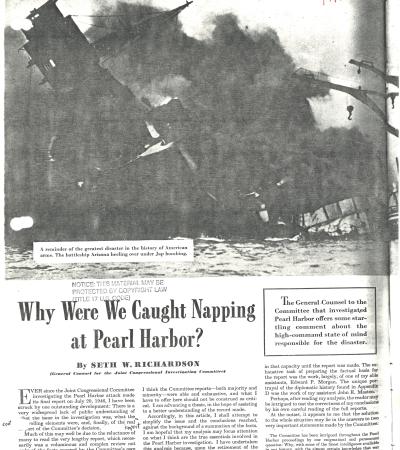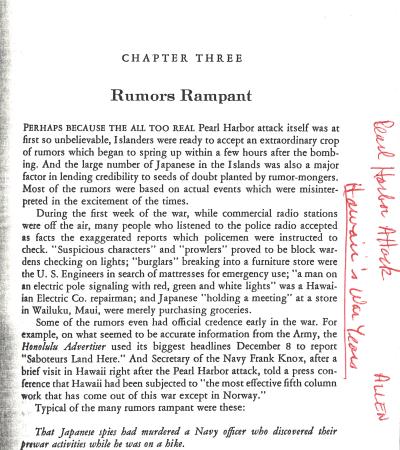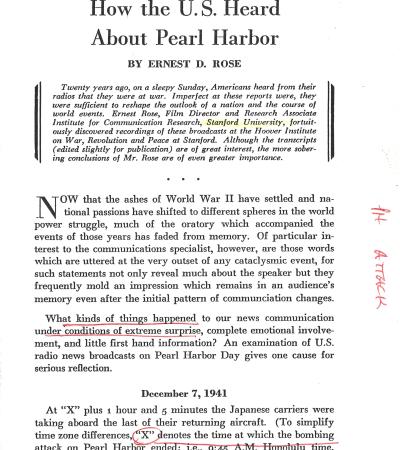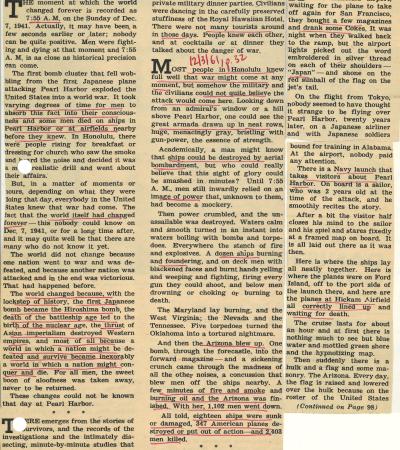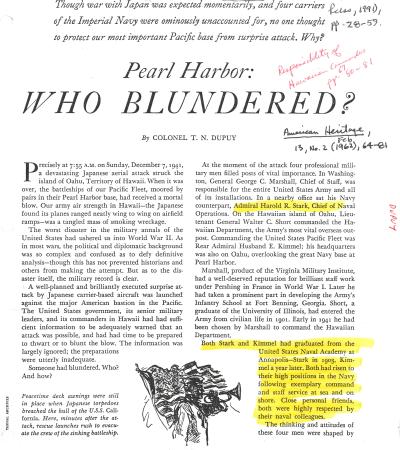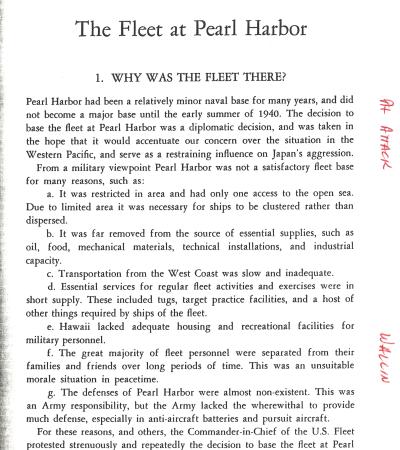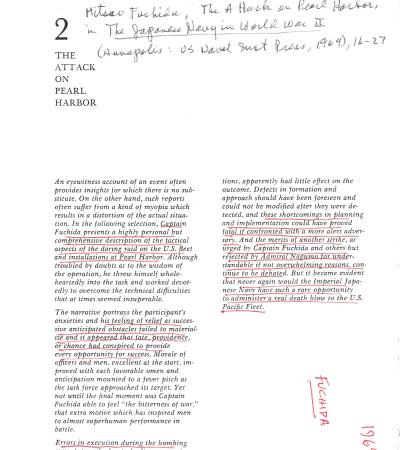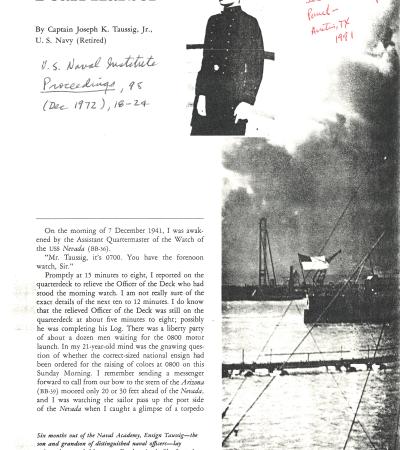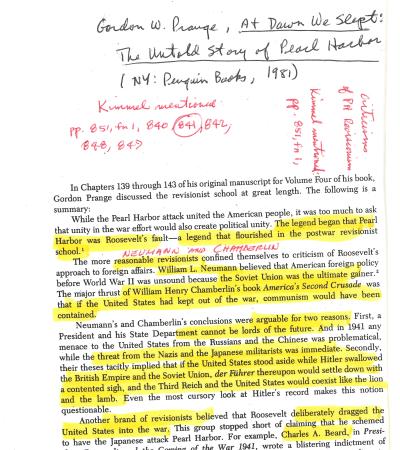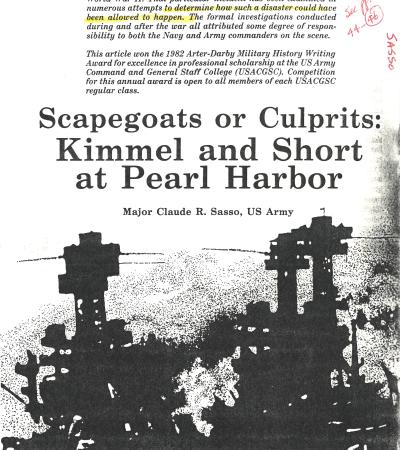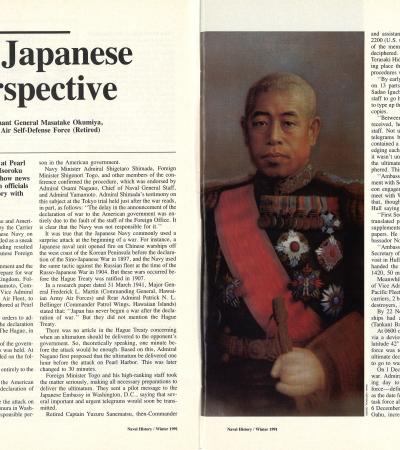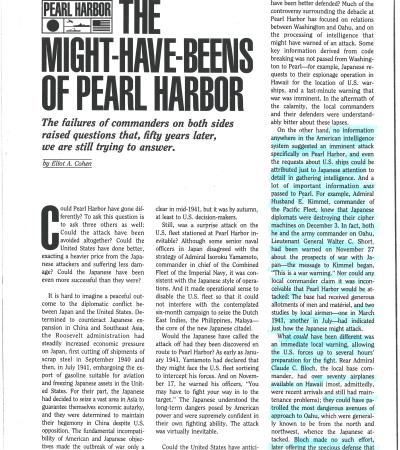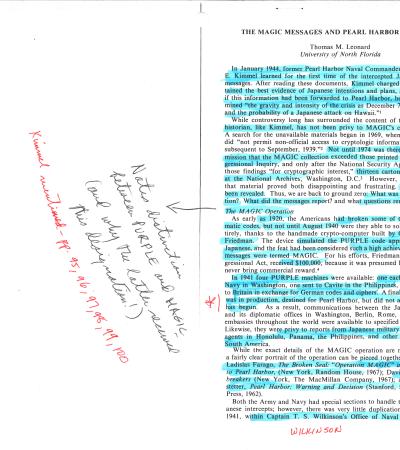Thomas C. Kennedy was a Professor of History at the University of Wyoming. Among his papers are book excerpts and magazine articles related to Pearl Harbor.
"Why Were We Caught Napping at Pearl Harbor?" by Seth W. Richardson, The Saturday Evening Post, May 24, 1947
This magazine article written by the General Counsel for the Joint Congressional Committee investigating the Pearl Harbor attack, discusses the widespread lack of public understanding regarding the committee's findings. Richardson aims to clarify the issues and conclusions of the investigation, attributing the surprise attack to a universal but inexplicable lapse in the perceived threat to Pearl Harbor after August 1941. He argues that this collective complacency led to inadequate defensive preparations and ultimately enabled the disaster on December 7, 1941.
"Rumors Rampant", Hawaii's War Years, 1950
This chapter of a book on Pearl Harbor addresses some of the many rumors that circulated following the attack on Pearl Harbor. It also provides relevant facts to counter various conspiracies that sprung up in Hawaii and beyond.
"How the U.S. Heard About Pearl Harbor" by Ernest D. Rose, Journal of Broadcasting, 1961
This article analyzes the news reports that occurred immediately following the Pearl Harbor attack. It highlights the chaotic and emotionally charged nature of the initial reports, which, despite their imperfections, significantly impacted American public sentiment and perception of historical events. Rose's analysis underscores the importance of accurate and responsible communication, especially during times of crisis.
"The Day the World Changed Forever" by A.M. Rosenthal, December 3, 1961
The newspaper article reflects on the significance of the Pearl Harbor attack, emphasizing its pivotal role in transitioning the world into an era of total peril. It describes how the attack not only plunged the United States into World War II but also marked the end of the battleship era and the beginning of the nuclear age. The article highlights the lasting impact on global power dynamics and the psychological shift towards acknowledging the inescapable realities of modern warfare.
"Pearl Harbor: Who Blundered?" by Colonel T.N. Dupuy, American Heritage, 1962
This article examines the failure of U.S. military leadership to anticipate and adequately prepare for the Japanese attack on Pearl Harbor. Despite having intelligence to predict the possibility of an attack, key figures failed to take necessary precautions. The article highlights the miscommunications and assumptions that contributed to the catastrophic surprise.
Excerpts from Pearl Harbor: Why, How, Fleet Salvage and Final Appraisal by Homer N. Wallin, 1968
These book chapters cover the fleet at Pearl Harbor, the imminence of war, the results of the surprise Japanese air raid and a final appraisal of the Pearl Harbor attack.
"The Attack on Pearl Harbor" from The Japanese Navy in World War II, 1969
This book chapter covers an eyewitness account by Japanese Captain Fuchida of the attack on Pearl Harbor. He recounts that even the pilots flying the bombing mission were not told in advance about the plans to attack.
"Setting the Record Straight" by Al Hemingway, Military History, December 1991
This magazine article includes an interview with Jesse E. Pond, Jr; a Navy fireman, who manned guns on a destroyer that fought back against the Japanese air assault at Pearl Harbor. At the time of the interview, Pond was president of the Pearl Harbor Survivors Association.
"I Remember Pearl Harbor" by Captain Joseph K. Taussig, Jr., U.S. Naval Institute Proceeedings, December 1972
This article covers the reflections of a young naval ensign who was wounded aboard the USS Nevada battleship during the attack on Pearl Harbor.
"Revisionists Revisited"
This article is a summary of the revisionist theories of the Pearl Harbor attack. It concludes that while President Roosevelt made mistakes in the lead up to Pearl Harbor, the revisionist theories regarding Roosevelts culpability for Pearl Harbor remain unsubstantiated.
"Scapegoats or Culprits: Kimmel and Short at Pearl Harbor" by Major Claude R. Sasso, Military Review, 1983
This article analyzes the roles played by Admiral Husband E. Kimmel and Lieutenant General Walter C. Short in Pearl Harbor and concludes that while Kimmel and Short were, to some degree culprits, they were also made scapegoats.
"The Japanese Perspective" by Lieutenant General Masatake Okumiya, Naval History, 1991
This article, written by a Japanese naval officer who had participated in the attack on Pearl Harbor, details the timeline of Japanese governmental and diplomatic channels leading up to the Pearl Harbor attack. He concludes that the Pearl Harbor attack was a brilliant success from the point of view of military tactics and strategy.
"The Might-Have-Beens of Pearl Harbor" by Eliot A. Cohen, Military History Quarterly, 1991.
This article asks critical questions about Pearl Harbor, including: Could the attack have been avoided? Could the U.S. have done a better job defending itself? Could the Japanese have been even more successful?
"The Magic Messages and Pearl Harbor Revisited" by Thomas M. Leonard, 1976
This article explains the U.S. military code breaking operations and processes prior to Pearl Harbor. It concludes that the content of the decoded messages did not indicate that Japan would strike at Hawaii.
